Blueberries are gorgeous plants. With fragrant spring blooms, stunning fall color, and vibrant summer berries, they are as deserving of space in the ornamental garden as they are among row crops. No matter where you plant them, these blueberry companion plants will help you get the most from your plantings—whether your goals are boosting fruit production or creating a beautiful edible landscape. Planting blueberry companion plants is a great way to attract pollinators, manage weeds, and conserve soil moisture.
Three different types of blueberry plants can be grown in the South. Rabbiteye blueberries (Vaccinium virgatum) are native to the southeast and are quite heat tolerant. They perform well through the middle, lower, and coastal South, as do southern highbush blueberries. Southern high bush blueberries (Vaccinium x corymbosum) are a hybrid developed at the University of Florida to produce plants with high fruit quality and productivity, along with the low chilling requirement necessary to produce berries in the Deep South. The third type of plant is northern highbush
blueberries (V. corymbosum), which works well in the upper and middle South.
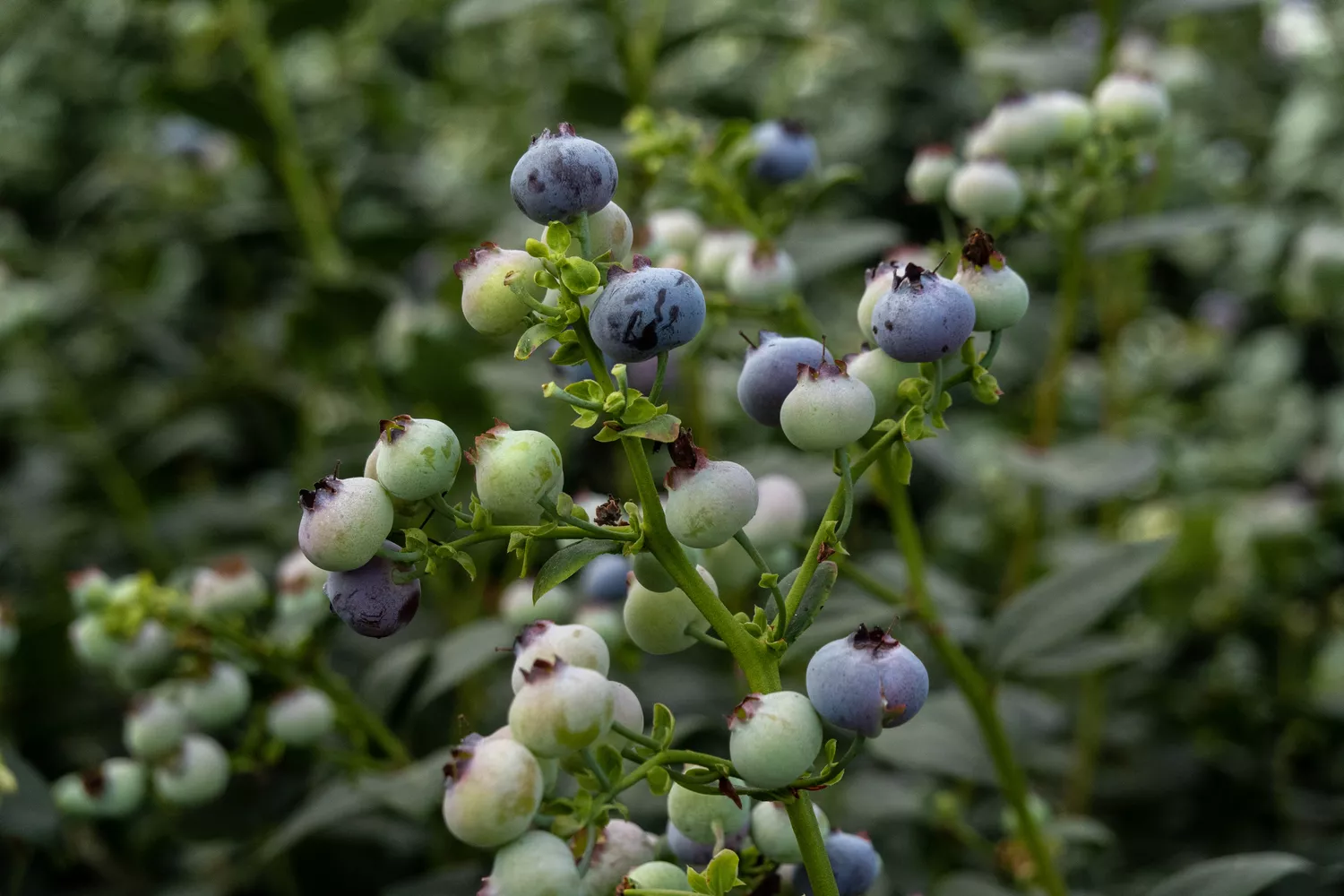
Blueberries require full sun and acidic soil, ideally with pH between 4.0 to 5.5, so blueberry companion plants must also thrive under these conditions. Blueberry plants also have a shallow root system that can be disturbed by planting annuals and is subject to competition from surrounding plants for water and nutrients. Provide plenty of space between blueberry plants and their companions to limit competition.
Companion Plants To Boost Pollination
Although many blueberry cultivars are considered self-pollinating, all blueberries will produce larger yields and higher quality fruit with cross pollination between two or more blueberry plants. This requires the work of bees—both native species and the domestic honeybee. Planting companions that bloom around the same time and are known to attract blueberry pollinators is a great way to boost berry production. Here are a few great options.
Crimson Clover
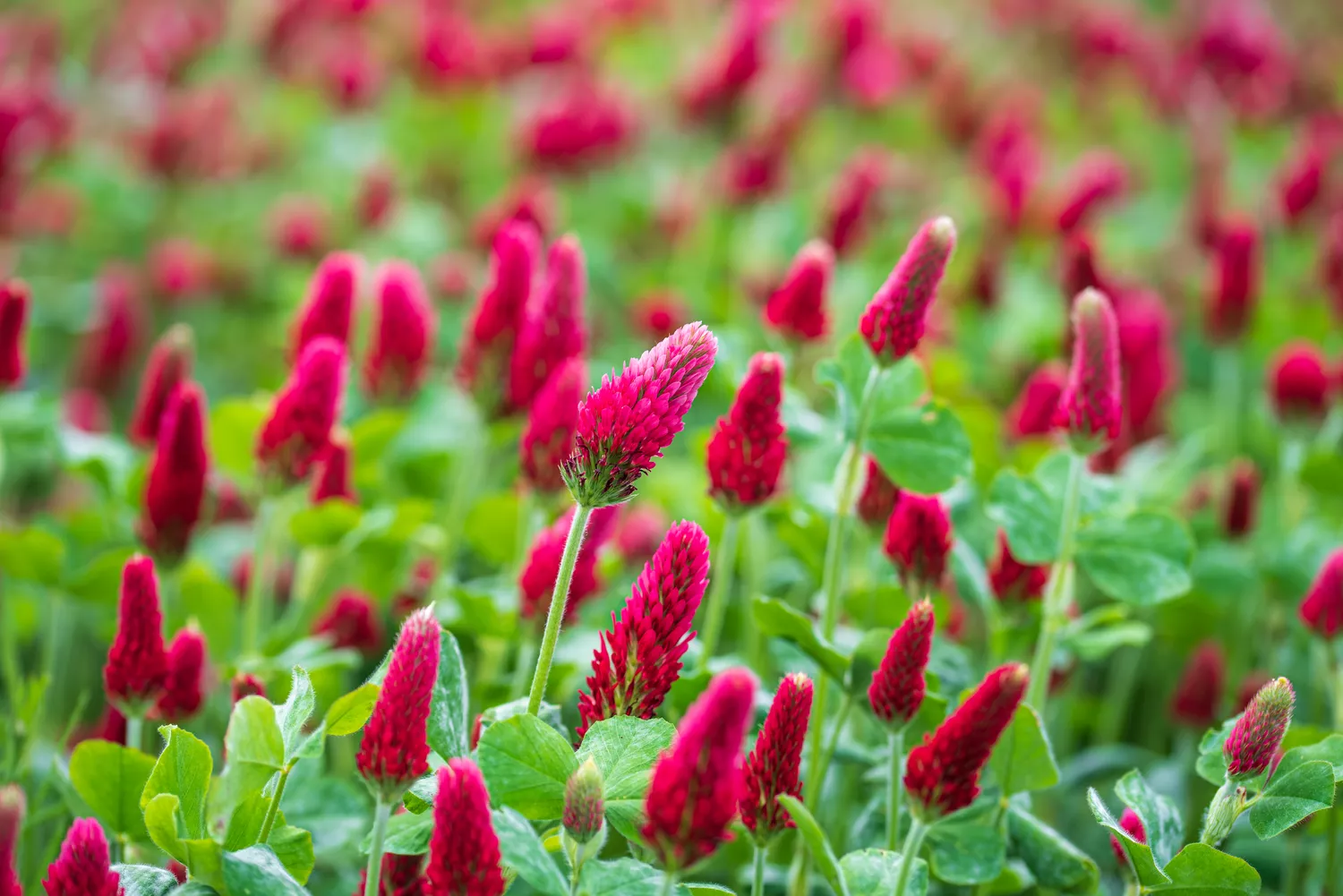
- Botanical Name: Trifolium repens
- Sun Exposure: Full Sun
- Soil Type: Well-draining, Rich
- Soil pH: Acidic to Neutral (5.5–7.0)
Crimson clover is a cool-season annual that blooms in early spring, providing a rich source of pollen and nectar to native bees which helps attract these pollinators to blueberry plants. As a legume, crimson clover also fixes nitrogen in the soil, so this companion plant works double duty. The flowers are quite lovely and harbor minute pirate bugs (Orius spp.), an insect that feeds on plant pests including thrips, spider mites, and aphids. Crimson clover is best suited to production gardens, as it can become weedy in landscape beds.
Virginia Bluebells

- Botanical Name: Mertensia pulmonarioides
- Sun Exposure: Part Sun to Shade
- Soil Type: Medium, Well-draining, Average Fertility
- Soil pH: Acidic to Alkaline (5.5 – 8.5)
Although this lovely native wildflower is more of a woodland species, it can be planted near blueberries in ornamental plantings or along the edges of fruit plantings to attract pollinators. It is a preferred foraging plant for bumblebees, which are important blueberry pollinators, and blooms around the same time as blueberries. Plant in masses for a beautiful display of the tubular blue to pink blossoms.
Redbud

- Botanical Name: Cercis canadensis
- Sun Exposure: Full Sun to Part Shade
- Soil Type: Medium, Well-draining, Average Fertility
- Soil pH: Acidic to Alkaline (5.0 to 8.0)
Redbuds are a common forage plant for bumblebees and the southeastern blueberry bee. As its name suggests, the southeastern blueberry bee is our most efficient pollinator of blueberry plants, on which it specializes. Attracting this pollinator, as well as honeybees and bumblebees, to the landscape in early spring will increase pollination and yields. With masses of early to mid-spring blooms, redbud trees are hard to miss and will surely draw pollinators to the landscape.
Groundcovers as Blueberry Companion Plants
While groundcovers and living mulches are a good way to support deep-rooted crops like fruit trees, they can be problematic around blueberries. The shallow root system of blueberry plants can be restricted by competition from aggressive groundcovers, particularly when they are planted too close together. On the other hand, in traditional row planting systems, there is a lot of open space between blueberry bushes that leaves room for weed growth. Using groundcovers to manage weeds in these systems can be highly beneficial. In ornamental plantings, groundcovers are desirable from an aesthetic point of view and can be used with care. Wait until blueberry bushes are well-established before planting groundcovers or living mulches nearby and provide ample irrigation for both plants. Mulch young plants with pine straw, bark, or other non-living organic mulch until established. Around older plants, you can try these groundcovers.
White Clover
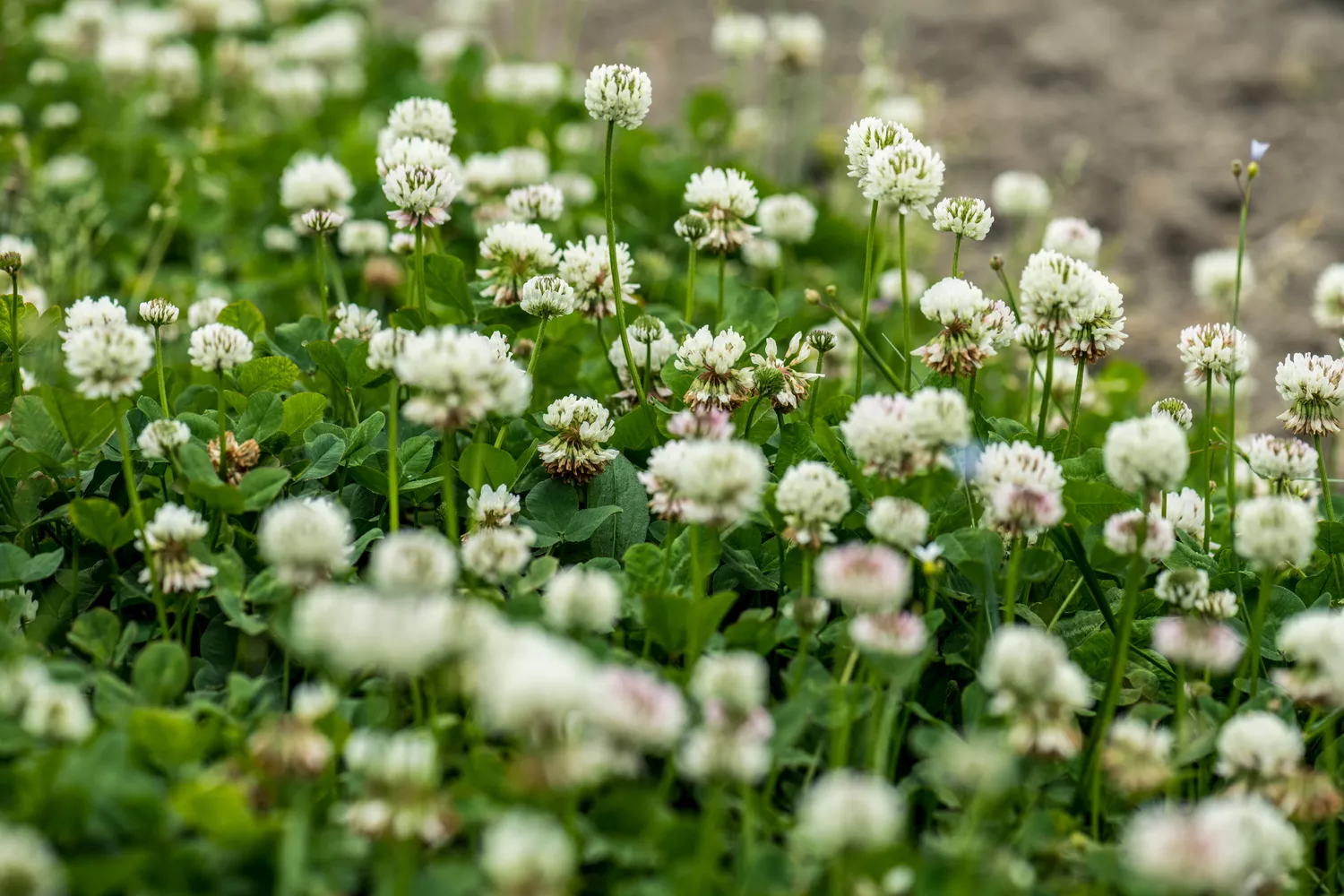
- Botanical Name: Trifolium repens
- Sun Exposure: Full Sun to Part Shade
- Soil Type: Medium, Well-draining, Average Fertility
- Soil pH: Acidic to Neutral (5.1–7.3)
White clover is the living mulch of choice for irrigated vegetable crops, orchards, and among fruit bushes. White clover is a legume that fixes nitrogen in the soil, making it available to nearby plants. When growing blueberries in rows, use white clover in the space between rows to protect soils against erosion, fix nitrogen, attract pollinators, and suppress weeds.
Strawberries

- Botanical Name: Fragaria x ananassa
- Sun Exposure: Full Sun
- Soil Type: Moist, Well-draining, Rich
- Soil pH: Slightly Acidic (5.5-6.8)
Strawberries are commonly planted beneath established blueberry bushes in permaculture plantings. This pairing translates well to both ornamental and edible gardens. From an ornamental perspective, strawberries produce a beautiful groundcover of deeply lobed foliage and white flowers, along with a crop of sweet fruit. This pairing is a great way to boost fruit production in a small space.
Creeping Thyme
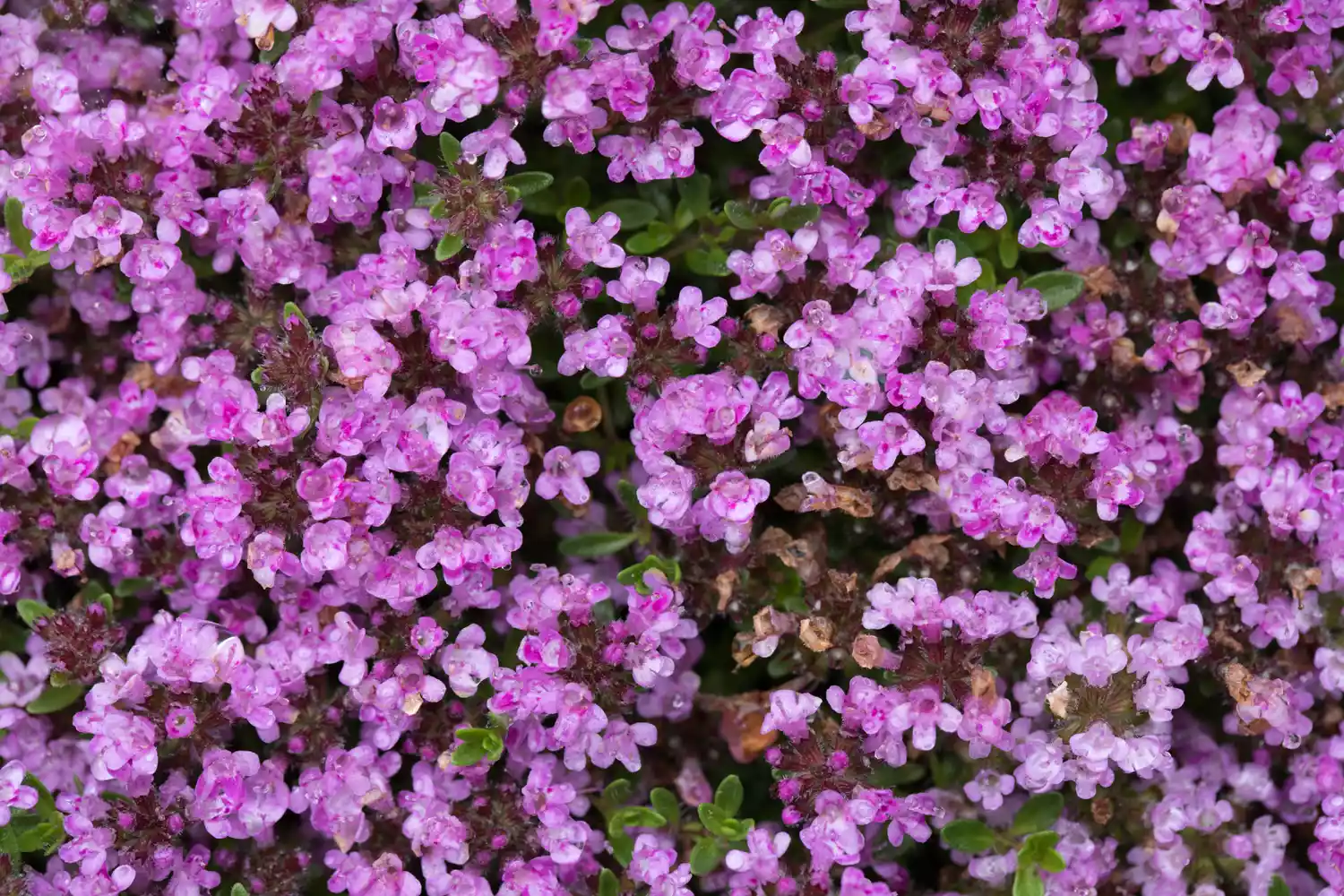
- Botanical Name: Thymus serpyllum
- Sun Exposure: Full Sun
- Soil Type: Well-draining, Average
- Soil pH: Slightly Acidic to Slightly Alkaline (6.0-7.5)
Creeping thyme is a favorite groundcover for its edible foliage and colorful blooms. Although thyme performs best in more neutral to alkaline soils, it tolerates a wide range of soil pH, including acidic conditions. This sprawling groundcover is great at controlling weeds. In hot climates, a layer of thyme helps keep soils cool and conserve soil moisture by reducing evaporation.
Ornamental Blueberry Companions
Blueberries are beautiful bushes, producing white, bell-shaped flowers in spring and turning vibrant shades of red and orange in autumn. They make a wonderful addition to ornamental planting beds and can be grown as an edible hedge. Plant them in masses in your pollinator or rain gardens but be sure to limit competition from neighboring plants by providing plenty of space for root development. Blueberries perform best alongside plants that have similar soil requirements, namely acidic conditions.
Rhododendron and Azaleas

- Botanical Name: Rhododendron species
- Sun Exposure: Sun to Part Shade
- Soil Type: Moist, Well-draining, Rich
- Soil pH: Acidic (4.5–6.0)
Rhododendrons and azaleas are beloved landscape plants for Southern gardens. They thrive in acidic soils and produce gorgeous spring blooms. They flower around the same time as blueberries and are a preferred forage plant of southeastern blueberry bees, helping attract this important pollinator to the garden. Rhododendrons thrive with morning sun and afternoon shade, while some newer azalea cultivars tolerate full sun.
Flowering Dogwood
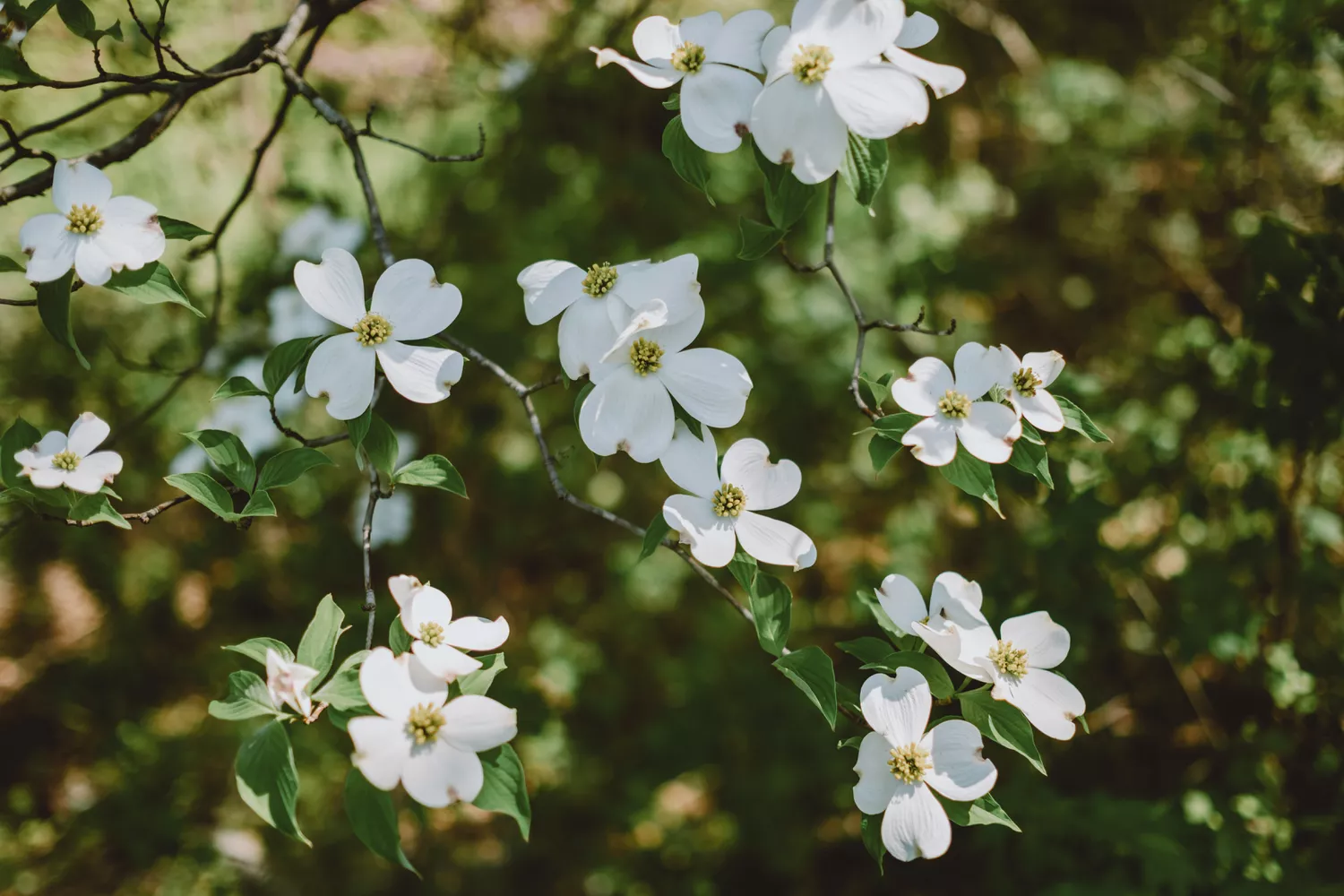
- Botanical Name: Cornus florida
- Sun Exposure: Full Sun to Part Shade
- Soil Type: Medium, Well-draining, Average Fertility
- Soil pH: Acidic to Neutral (5.0–7.0)
Another staple of the Southern landscape, flowering dogwood makes a great companion to blueberries. It thrives under the same soil conditions and its stunning white blooms attract bumblebees to the garden. It blooms toward the tail end of redbud flowering period, extending the window of flowering activity in the landscape. The bright red fruits are a favorite of songbirds.
Hollies

- Botanical Name: Ilex species and cultivars
- Sun Exposure: Full Sun to Part Shade
- Soil Type: Medium, Well-draining, Average Fertility
- Soil pH: Acidic to Neutral (4.5-7.0)
A great many holly species thrive in the South under the same growing conditions as blueberries. These trees and shrubs range in size from compact mounds to pyramidal trees, offering endless design opportunities. Most are broadleaf evergreens, though a few deciduous species also grace Southern gardens. The most desirable feature among hollies is their bright berries, which ripen in autumn and tend to linger throughout winter.
What Not To Plant with Blueberries
In edible gardens and ornamental plantings alike, there are certain plants that are best kept away from blueberries. Because blueberries have shallow root systems, it is best to use only perennial or seed-sown annuals as groundcovers and living mulches. This will prevent root disturbance during planting. To remove annual groundcovers, like crimson clover, simply cut the above ground portion for the roots, rather than pulling out plants.
It is also helpful to avoid plants with conflicting soil needs. Blueberries are acid loving, while crops like tomatoes and eggplant require more neutral soils. These crops are also heavy feeders, as are potatoes, cabbage, kale, and broccoli. Avoid planting them near blueberries as they will compete for
nutrients. Asparagus is also a heavy-feeder, and it prefers more alkaline soil conditions.
Finally, do not plant blueberries near walnut trees. Walnuts produce a chemical in their roots called juglone that many plants, including blueberries, are sensitive to. Juglone is meant to kill the competition, making way for the walnut tree’s root system. Because they have a very extensive root system, you will want to locate blueberries far away from these trees.





